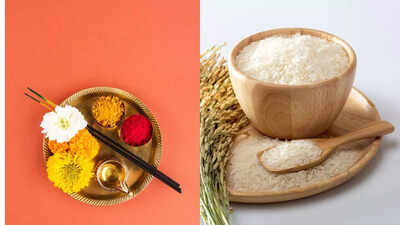ARTICLE AD BOX

Since ages, we have been told to avoid eating grains, spices, lentils and even rice on Ekadashi, but do you know why it was suggested to abstain from certain foods on this day? Let’s find out…What is Ekadashi?Today is Nirjala Ekadashi, which is one of the most spiritually powerful vrat according to the Hindu calendar.
Ekadashi falls on the 11th lunar day of the Shukla Paksha in the month of Jyeshtha (May–June).
Interestingly, the word ‘Nirjala’ means without water and this Ekadashi vrat is observed fasting without water and certain foods. In some cultures this vrat is also observed by observing Maun vrat as it revolves around complete abstention from both food and water for 24 hours. In fact, it is believed that it is one of the toughest Ekadashi vrats among the 24 Ekadashi’s that fall throughout the year. But do you know why Ekadashi is observed? Read on to find out…Why is Ekadashi observed?According to Hindu mythology and beliefs, Ekadashi is observed to worship as well as honour Lord Vishnu, the protector and sustainer of the universe.
According to the Hindu scriptures, fasting on Ekadashi helps cleanse sins, purify the mind and body, and may bring spiritual upliftment. In fact, each Ekadashi has its own significance, but all these Ekadashi vrats are linked to improve self-control, devotion, and practice detachment from worldly pleasures.The Padma Purana and other Vedic texts describe that observing Ekadashi helps neutralize past karma, aids in controlling the senses, and contributes to spiritual awakening.
The day is also aligned with lunar cycles that affect human physiology, making fasting on this day not only spiritual but also beneficial to health, especially in promoting better digestion and mental clarity.What Makes Nirjala Ekadashi Special?Unlike other Ekadashis where one may consume fruits, milk, or water, Nirjala Ekadashi is unique for its strict austerity — no food, no water — for 24 hours. It is believed that those who are unable to observe all 24 Ekadashis in a year can observe just this one to gain the benefits of all.This Ekadashi is linked to Bhima, the mighty Pandava brother from the Mahabharata, who found it difficult to fast twice a month. Sage Vyasa advised him to observe just one Nirjala Ekadashi with full devotion and strictness, which would grant him the spiritual merit of all the other Ekadashis combined.Foods to Avoid on EkadashiEkadashi fasting comes with a clear set of dietary restrictions. The idea is to promote sattvic (pure) living, minimize indulgence, and enhance self-discipline. Here are the key foods that must be strictly avoided:Grains and CerealsRice, wheat, lentils, barley, and any grain-based food (including roti, bread, and pasta) are strictly avoided.
These are considered tamasic (promoting lethargy and dullness) and are believed to interfere with spiritual energy on Ekadashi.Beans and PulsesLegumes such as moong, chana, rajma, and urad dal are also forbidden. They are said to be harder to digest and considered impure (ashuddha) for this sacred day. Vegetables Like Onions and GarlicOnions and garlic, which are part of the tamasic and rajasic food categories, are also restricted as they are believed to increase agitation and impure thoughts. Spices and AdditivesCommon additives like hing (asafoetida), baking soda, and certain preservatives are avoided because they are often processed with grains.Water (on Nirjala Ekadashi)While most Ekadashis allow drinking water, Nirjala Ekadashi prohibits even that — hence the name “Nirjala.” This fast requires immense willpower and dedication.Why Should You Avoid Rice on Ekadashi?The abstinence from rice on Ekadashi has spiritual as well as mythological roots.
According to a popular belief from the Bhavishya Purana, the rice grains consumed on Ekadashi transform into worms in the body, attracting negative karma. It is believed that the presiding deity of grains — Lord Vishnu himself — rests on Ekadashi. Therefore, consuming grains on this sacred day is considered disrespectful.Ayurveda and yogic traditions also suggest that grains, particularly rice, are heavy and increase inertia or 'tamas'.
Avoiding them helps the body stay lighter and the mind clearer, which is ideal for spiritual practices such as meditation, chanting, and prayer.What Foods Are Allowed?Though Nirjala Ekadashi calls for a strict fast, those who are not able to do Nirjala fasting due to health reasons (especially the elderly, children, pregnant women, or those on medications) may follow a simple Ekadashi diet, excluding prohibited foods. Here's what’s generally allowed:Root VegetablesVegetables like potatoes, sweet potatoes, and arbi (colocasia) can be consumed, often cooked without turmeric or red chili powder.
Use of rock salt (sendha namak) is preferred over iodized salt.Milk and DairyMilk, curd, paneer, and buttermilk are allowed and are commonly consumed by those doing partial fasting. These foods provide nourishment and support physical endurance during the fast. Nuts and Dry FruitsAlmonds, cashews, dates, raisins, and coconut can be eaten in moderation. They’re energy-dense and keep you feeling full for longer hours.Sabudana and KuttuSabudana (tapioca pearls) and kuttu (buckwheat) are commonly used to make Ekadashi-special dishes like sabudana khichdi, kuttu paratha, or pakoras.Can’t eat your food without snapping a picture first?Join our Food Photography Contest and stand a chance to win exciting prizes!Click HERE for details.Join our WhatsApp Food Community to discover delicious recipes, enjoy fascinating food stories, and stay updated with the latest food news! Click here



.png)
.png)
.png)
















 13 hours ago
4
13 hours ago
4









 English (US) ·
English (US) ·